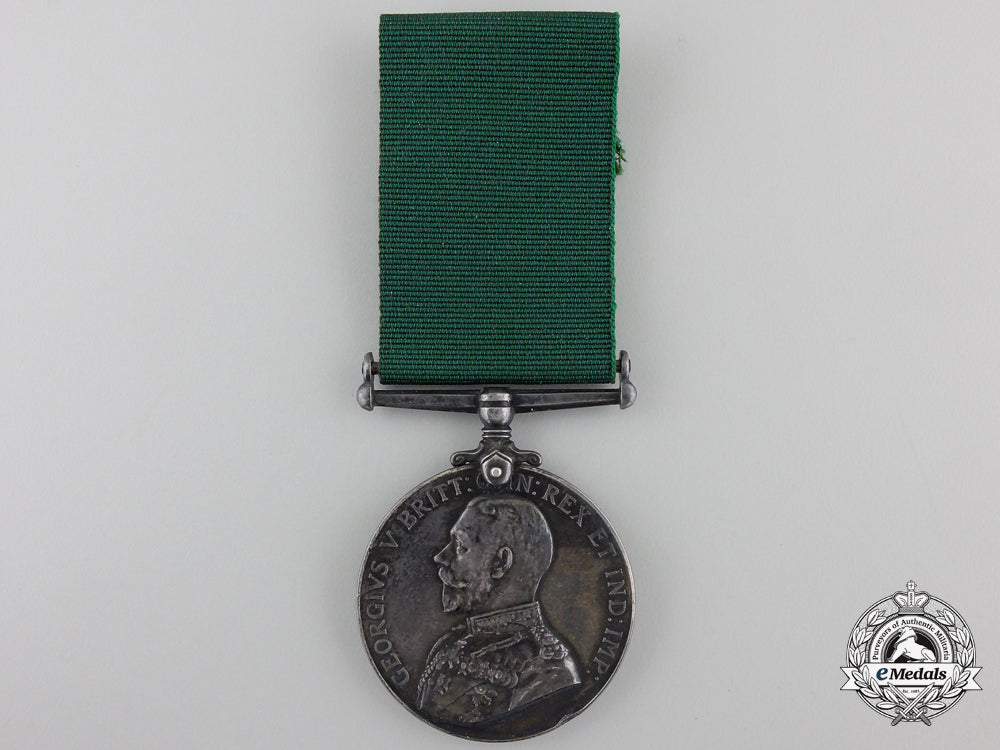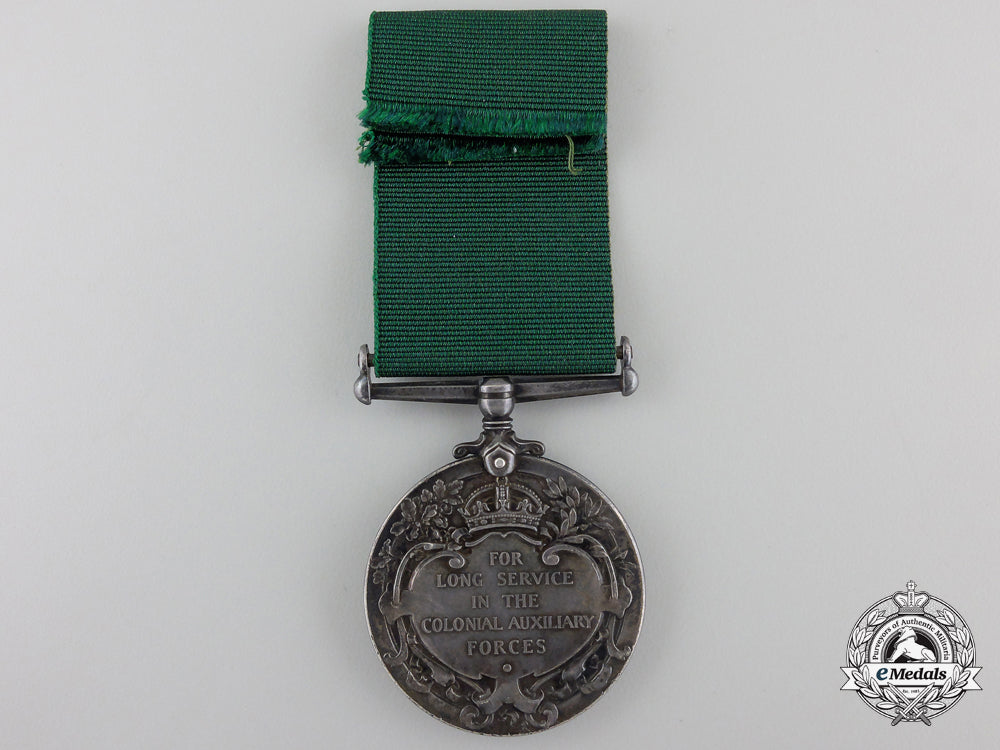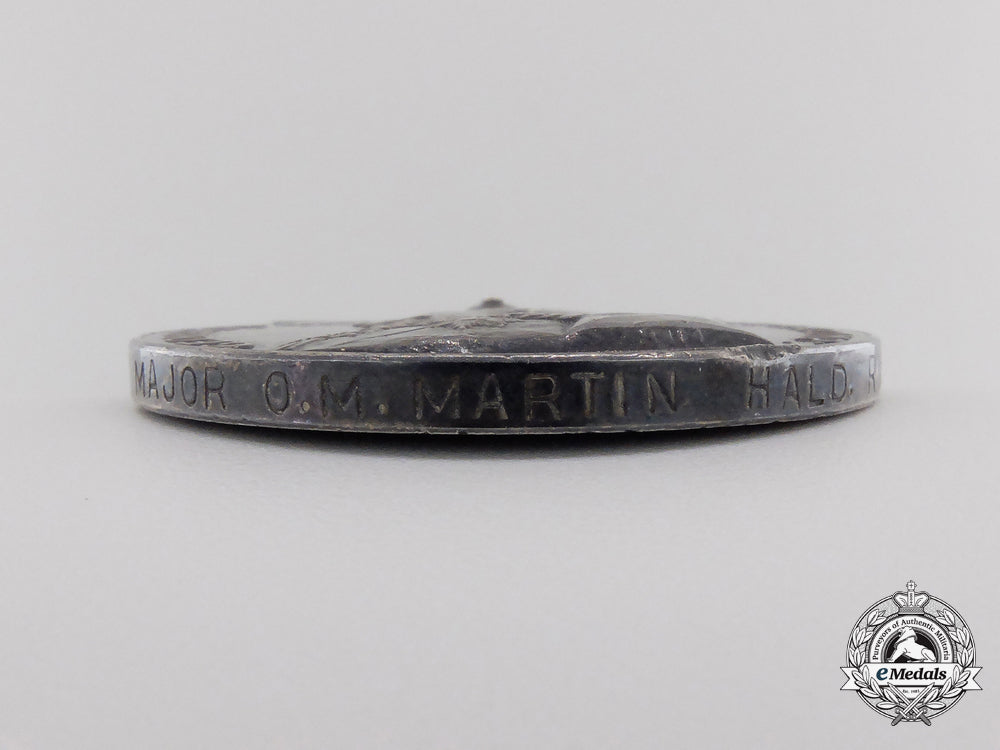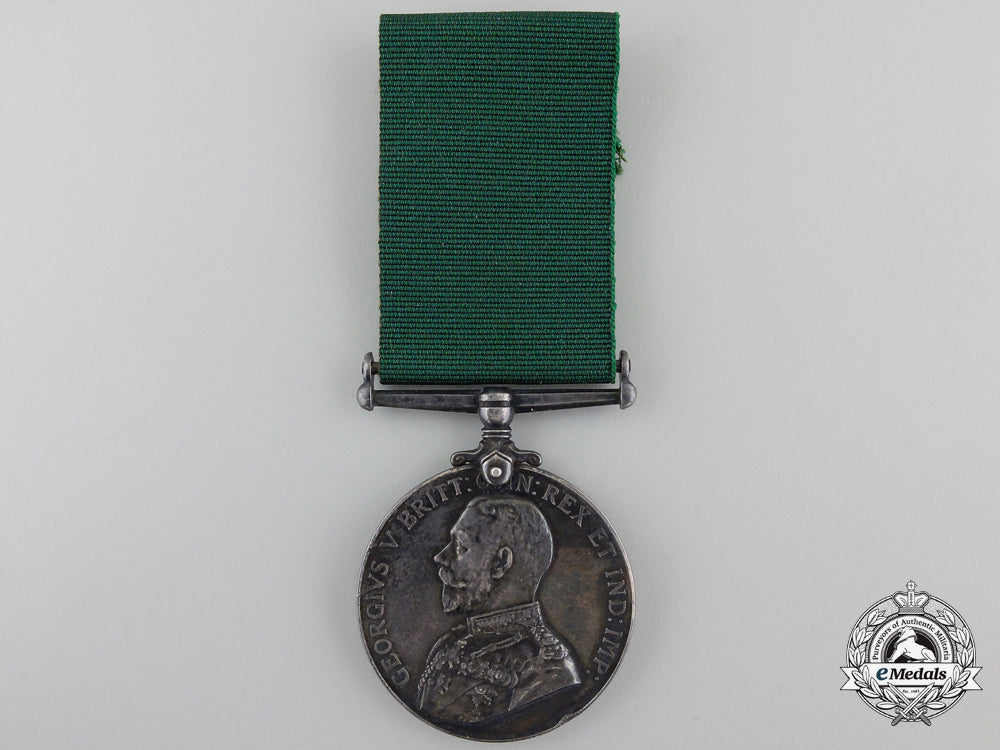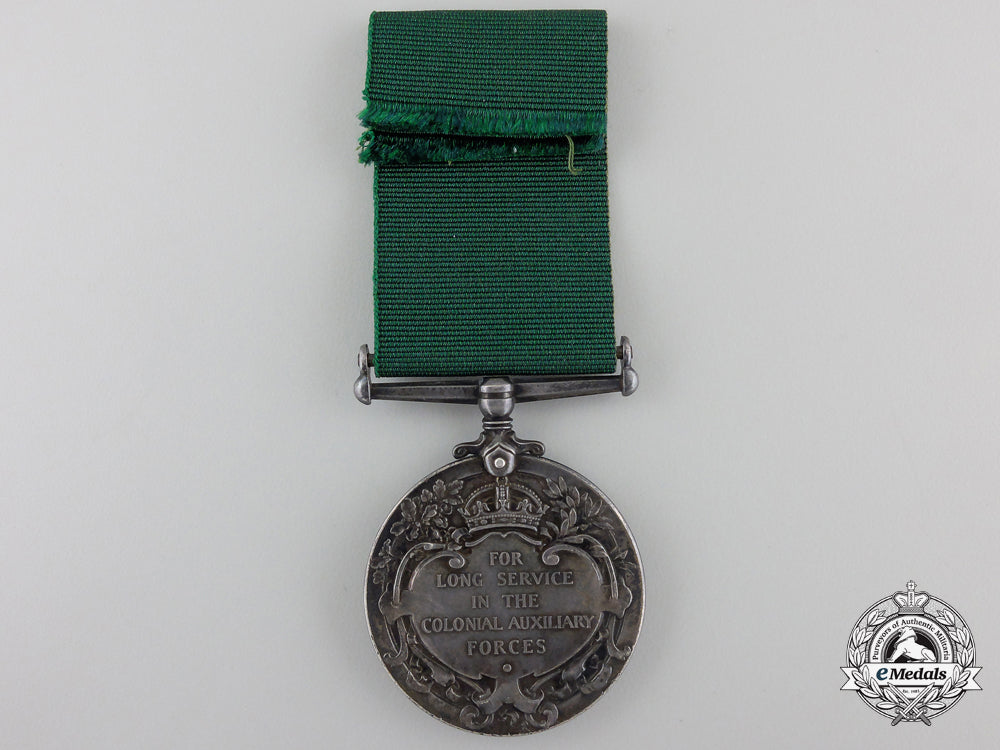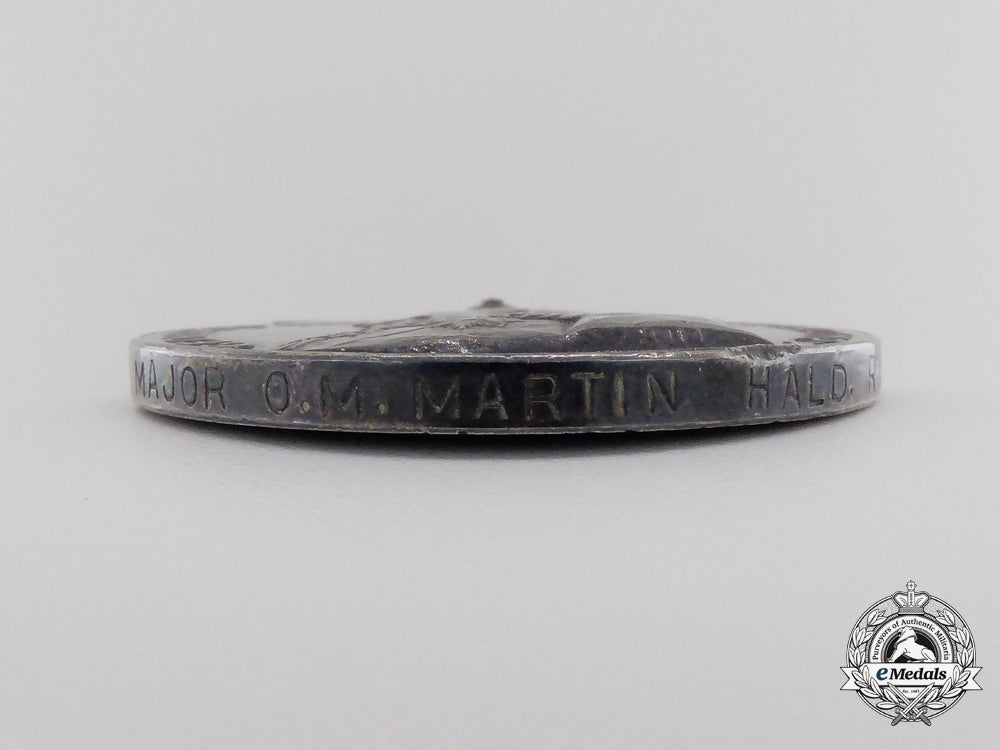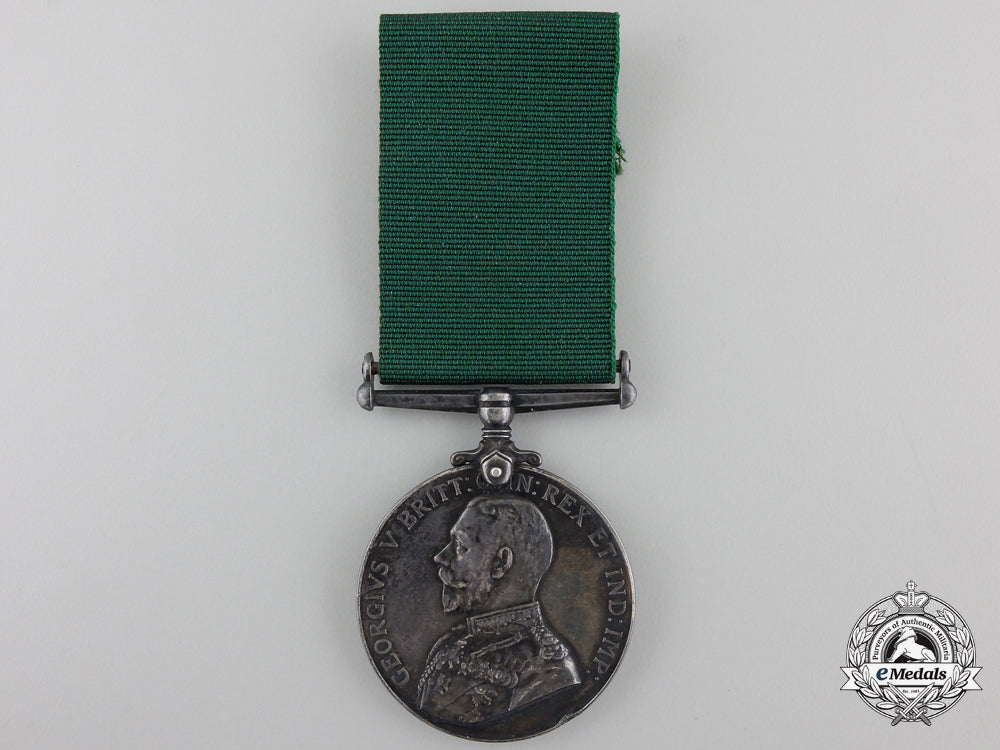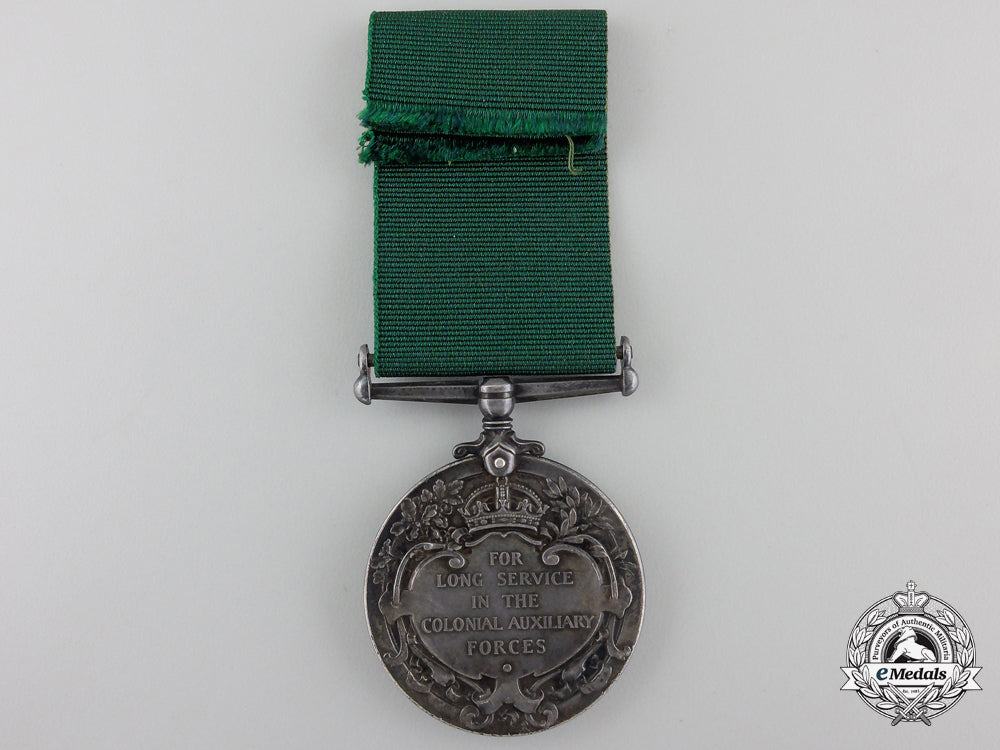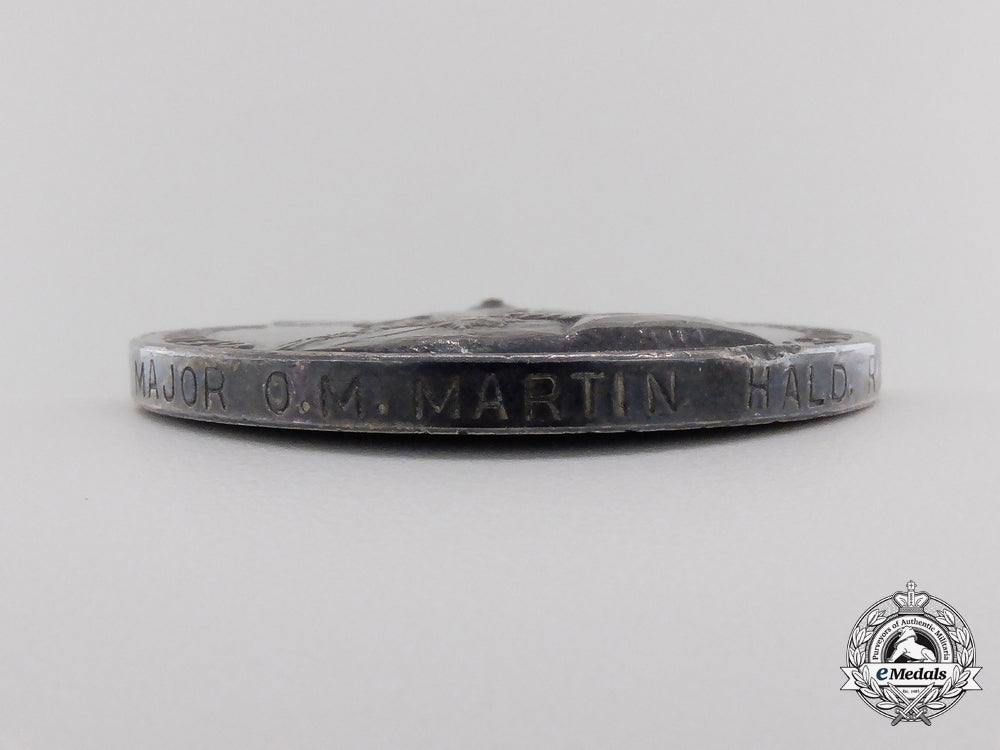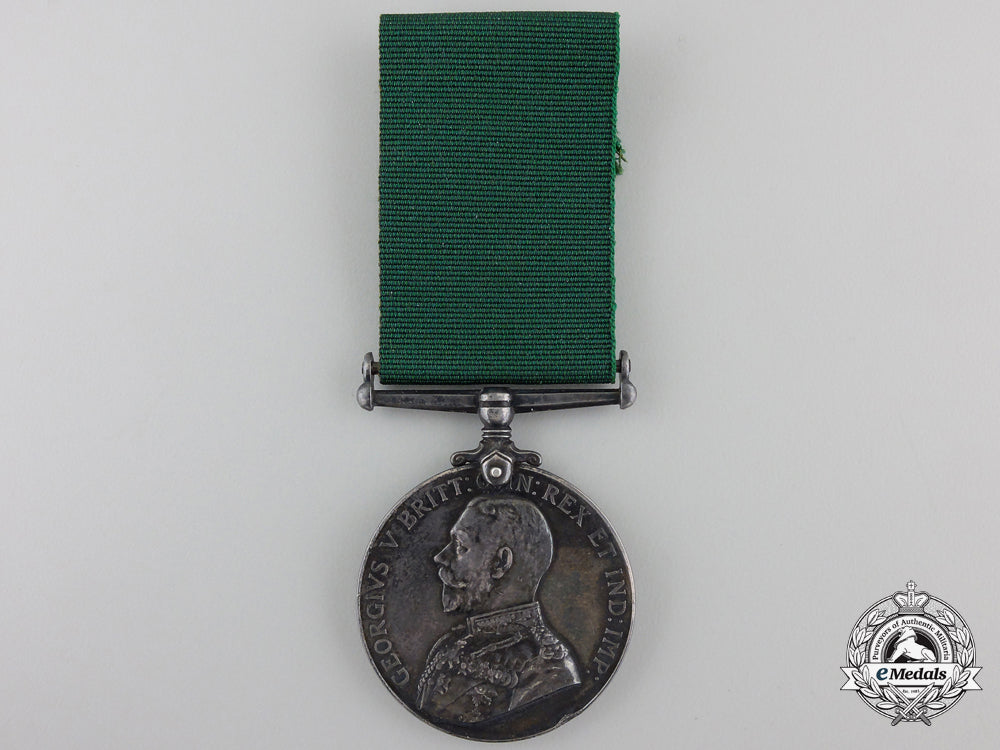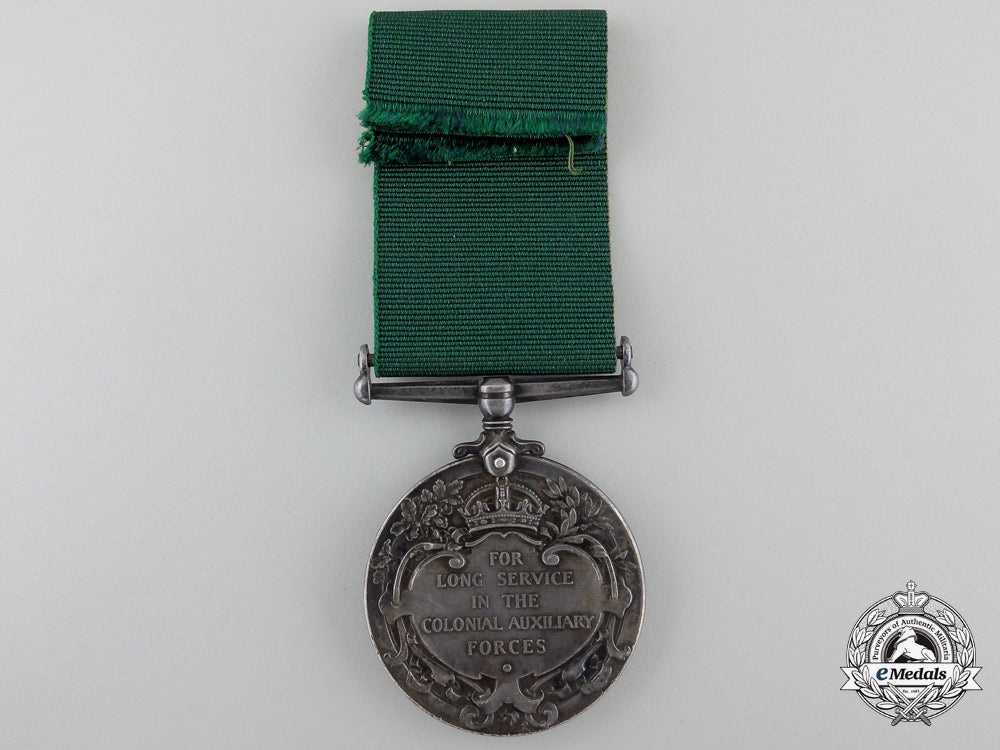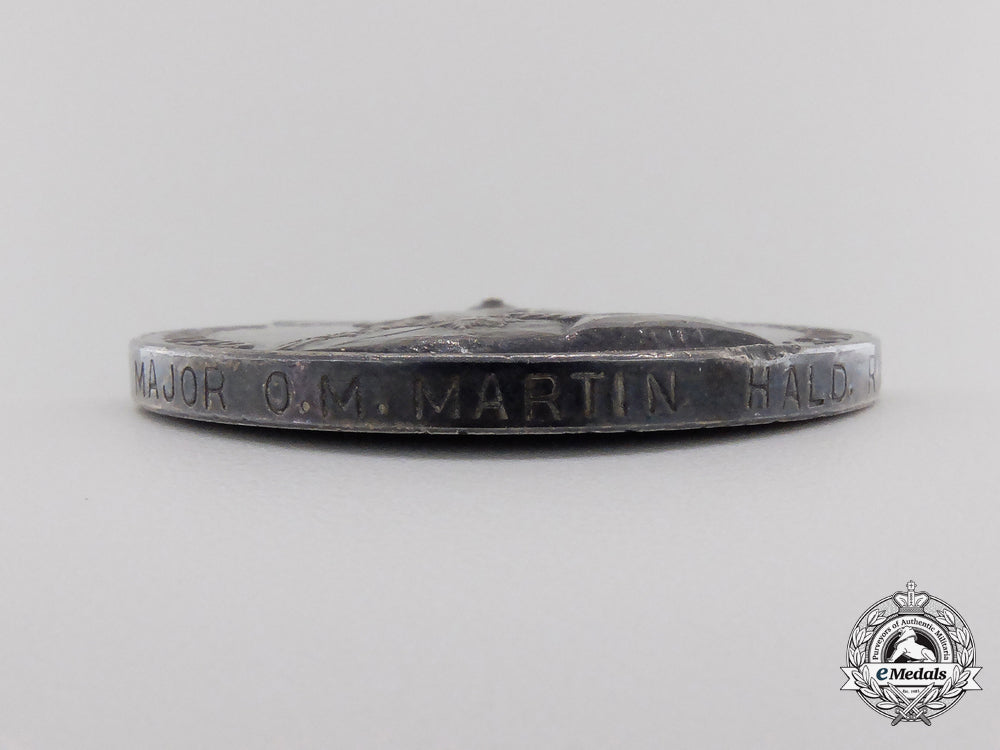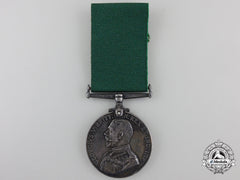Description
Colonial Auxiliary Forces Long Service Medal, Major (Later Brigadier) Oliver M. Martin, Haldimand Rifles, Canada's Highest Ranking Aboriginal Soldier and the First Native Appointed to the Judiciary in Ontario; (MAJOR O.M. MARTIN HALD. RIF.). Naming is officially impressed. Very dark patina, light contact, near extremely fine.
Footnote: Oliver Milton Martin was born on April 9, 1893, on Ohsweken, Ontario, the son of Robert Martin and Lucinda "Lucy" Martin (nee Miller). He had four sisters, Florence "Losie", Hellen, Mina and Bessie, along with two brothers, Leonard Lloyd and Melvin Newton. In his military career, he achieved the rank of Brigadier, the highest rank ever by an Aboriginal Canadian. In his civilian life, he was a school teacher, principal and Magistrate. A Mohawk from the Six Nations Grand River Reserve, Martin enlisted with the 37th Regiment "Haldimand Rifles" militia in 1909, assuming the task of "Bugler" as one of his first roles. He signed his CEF Officers' Declaration Paper as a Lieutenant with the 114th Infantry Battalion "Brock's Rangers", on February 9, 1916 at Cayuga, Ontario, at the age of 21, naming his next-of-kin as his father, Robert Martin of Ohsweken, stating that he had three years previous service with an Active Militia, the 37th Regiment "Haldimand Rifles", that his religion was Anglican (Church of England) and that his trade was that of School Teacher. He did not state his marital status, as it was not asked for on the form. His two brothers were later to follow in his footsteps, enlisting in the CEF. Melvin Newton Martin signed his Attestation Paper as a Private (739788) with the 114th Infantry Battalion "Brock's Rangers", on April 13, 1916 at Ohsweken, naming his next-of-kin as his father, Robert Martin, stating that he no previous military service, that he was not married and that his trade was that of Farmer. He also stated that he was born on November 28, 1899 in Tuscarora Township, Brant County, Ontario. The last digit on his form was changed to a "7", the date now reading 1897, thereby adjusting his age from 16 to 18 and enabling him to enter the service underage. The other brother, Leonard Lloyd Martin, signed on one week after Melvin, signing his Attestation Paper as a a Private (739813) with the 114th Infantry Battalion "Brock's Rangers", on April 20, 1916 at Ohsweken, naming his next-of-kin as his father, Robert Martin, stating that he had no previous military service, that he was not married and that his trade was that of Farmer, just like his aforementioned brother. He also stated that he was born on October 19, 1898 in Tuscarora Township, Brant County, Ontario, the authorities declaring that he was 18 on his Attestation Paper, when in reality he was 17 1/2. The Battalion was raised in Haldimand County and the Six Nations Reserve, with mobilzation headquarters at Cayuga under the authority of G.O. 151, December 22, 1915. The Battalion sailed November 1, 1916 under the command of Lieutenant-Colonel A.T. Thompson with a strength of 30 officers and 679 other ranks. In England, the Battalion was broken up and absorbed into the 35th and 36th Infantry Battalions. In England, Lieutenant Oliver was later transferred to the 107th Infantry Battalion "Winnipeg Battalion" (AKA Timber Wolf Battalion), which itself was re-designated the 107th Pioneer Battalion and served in France in that capacity. Martin served seven months in France and Belgium, where he survived a gas attack. On one occasion, Martin risked his commission on the good behaviour of his own people. The young lieutenant was assigned to conduct 400 Canadian Aboriginal soldiers from one camp to another. There was a four-hour stopover between trains in London. Martin's senior officers, possibly visualizing big black headlines about "Indians" whooping it up in the capital of the empire, ordered him to keep his men on the station platform the entire hour hours. This struck Martin as unfair. He gave his men leave in the city for the waiting period. They had just been paid, and there were plenty of taverns and hotels in the vicinity. But every man of the 400 was back in the station fifteen minutes before the train pulled out. To Martin, the incident proved that the "Indians" were as trustworthy as anybody else; to his associates, it stood as an example of the sort of loyalty which Martin inspired in his men in the First World War, and later, the Second World War. In 1917, he joined the Royal Flying Corps and qualified as an Observer, then earned his Pilot wings in 1918, the same year that the Royal Flying Corps and the Royal Naval Air Service merged to form the Royal Air Force on April 1st. As a rule, lack of education also restricted promotions within the Army. Many Aboriginal soldiers became Non-Commissioned Officers, Corporals, Lance Corporals and Sergeants, but a commission to the rank of Lieutenant or above was virtually impossible without education. The fact that a considerable number were commissioned indicates that race was not a limiting factor. Leadership roles built confidence and demonstrated that they were just as capable and intelligent as their non-Aboriginal comrades. A few managed to secure commissions: Lieutenant James David Moses of Ohsweken and Lieutenant John Randolph Stacey of Kahnawake became officers while in the Air Force, while Lieutenant Cameron Brant, Captain Alexander Smith, Captain Charles D. Smith and Lieutenant (later Brigadier) Oliver Milton Martin, all from Six Nations earned their rank in the Army, along with Hugh John McDonald from the Mackenzie Valley. Martin appears to have married sometime towards the end of the war and divorced in the early 1920s, his first wife returning to London, England with their daughter, Virginia (born 1918). Upon returning home to Canada in 1919, he lost his farm, which had been acquired through the Soldiers' Settlement. He had no taste for the cloistered life of the reserve. Like many other veterans, he tried selling bonds, Martin himself confessing that it was a resounding flop. Although discouraged, he turned his attention to the teaching profession. He owed this in part to an American minister, who had befriended him when he was about 16 years old. He had left the reserve and taken a job at a drug store in Rochester, New York, where he met the minister, who persuaded him to return to Canada and finish high school. Martin graduated from Normal school, which enabled him to enroll as a teacher at Secord School in East York, a suburb of Toronto. He stayed there until 1936, when he married one of the other teachers, a Canadian girl of Scottish descent, Jean "Lillian" Bunt, the marriage taking place in York, Ontario, near Cayuga. He left Secord school at this point, appointed principal of Danforth Park school in East York, a post he held until the outbreak of the Second World War, when he was abruptly recalled to the colours and placed in command of the 13th Infantry Brigade. Throughout this inter-war period, he maintained his ties to the militia regiment, assuming command of the Haldimand Rifles in 1930, and becoming the first commander of the newly amalgamated Haldimand Rifles and Dufferin Rifles on December 15, 1936, holding this position until the outbreak of the Second World War. Martin was to organize and train three brigades in Canada during the war, overseeing hundreds of recruits. His "smartness, efficiency and high morale were the trademarks of Martin-trained soldiers". Noted soldier, businessman, horse racing owner and owner of the Toronto Maple Leafs, Conn Smythe, declared him to be "One of the best soldiers in the Canadian Army." In 1940, he was invited to visit England on Special Military Service, then returned to Canada with his newly acquired knowledge. His first appointment, in the rank of Colonel, was as Commanding Officer of the 13th Infantry Brigade at a training camp at Niagara-on-the-Lake, Ontario, from June 13, 1940 to August 27, 1941. In the official history of the Algonquin Regiment, the Brigadier is remembered with fondness and respect. The Algonquins had arrived at Niagara-on-the-Lake after a long and festive train ride: "It was a sad and sore group of men who piled off the cars in Niagara. It was our good fortune to have Brigadier Martin as our new brigade commander, and he, sensing our condition, was most tactful and kindly. His first inspection of the unit, and his words to the men, won him at the outset our strong friendship and loyalty." Martin was later assigned to the Western Pacific Command, where he was promoted to Brigadier and went on to command the 14th (Nanaimo) Infantry Brigade, from August 28, 1941 to May 20, 1942, then the 16th (Prince George) Infantry Brigade, from May 21, 1942 to July 7, 1943. In October 1944, the Brigadier retired from active service. His impact, however, carried on for several years. According to one of his nieces, "many of Brigadier Martin's nephews and nieces joined the service during the Second World War. They wanted to serve their country and I'm sure they were influenced by their uncle's military career." He was named Commander of the 7th Division of the Canadian Army in the Hamilton-Niagara District in 1945. Martin was awarded the Colonial Auxiliary Forces Long Service Medal for his more than twenty years' service in the militia. After leaving the Armed Forces, Martin was appointed Provincial Magistrate for Ontario District 6, which included the counties of York, Halton and Peel, making him the first Native appointed to the judiciary in Ontario. He was noted as a "calm and gifted" Magistrate and was to serve in this capacity until his death in 1957. Although he lacked formal legal training, he never tried to "cover up" in court. When stumped by a point of law, he candidly admitted it and asked counsel for advice. He was noted for his particular carefulness in cases where police brought in signed confessions by the accused. He took the view that police ought to dig up the evidence themselves, and if there was the least hint of pressure or intimidation in obtaining a confession, he threw it out. His views towards the relationship and treatment of the Aboriginal peoples versus those of other Canadians are well documented in the February 1954 issue of The Native Voice: "The Indians of this country should be treated in every way like other Canadians. I think they should be allowed to vote, since they pay taxes on everything except income earned on the reserve. I think they should have liquor privileges like other Canadians. I had Indian soldiers under my command in both great wars and when they were given the same liquor rights as other Canadians, their behaviour is no better and no worse. Some get drunk, some don't. I think the history of our country should be written in such a way as to give the Indian people credit for their part in exploration and fishing and the fur trade. The history books should give them credit too, for their defence of British institutions in Canada, and for surrendering this whole country for settlement without the European people having to fight for it." Martin held that the much-heralded revision of the Indian Act, carried out by the last parliament of the time, was a failure so far as advancement of the Indian was concerned. "As I read the act, all the changes do is make it easier to administer." He also went on to explain: "I try to teach the Indians about the rest of the country and I try to educate the people of this country about the Indians. I'm in the happy position of knowing both sides." In 1953, he and his wife, Lillian, were invited to and attended the Coronation of Queen Elizabeth II on June 2nd. Martin died in late 1957, at the age of 64, as noted in the Globe and Mail of December 19, 1957. The East York Branch of the Royal Canadian Legion is named the Brigadier O. Martin Branch in his honour. He is also a member of Canada's Indian Hall of Fame.

